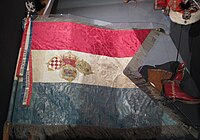
Back Üçcəhətli krallığı Azerbaijani Kolmikkuningriik Estonian Royaume triunitaire de Croatie-Slavonie-Dalmatie French הממלכה המשולשת HE Háromegy Királyság (Horvátország) Hungarian ტრიუნის სამეფო Georgian Триединое королевство Russian Троједна краљевина Serbian

The Triune Kingdom (Croatian: Trojedna kraljevina) or Triune Kingdom of Croatia, Slavonia and Dalmatia (Croatian: Trojedna Kraljevina Hrvatske, Slavonije i Dalmacije) was the concept—advocated by the leaders of the 19th-century Croatian national revival—of a united kingdom between Croatia, Slavonia and Dalmatia, which were already within the Austrian Empire under one king, who was also the Emperor of Austria, but were politically and administratively separate entities. This concept had roots in the high medieval period,[1] as a successor to the historical Kingdom of Croatia which was made up of those regions.
After 1867, Croatia and Slavonia were within the Hungarian half of Austria-Hungary and were united in 1868 as the Kingdom of Croatia-Slavonia, where the name Triune Kingdom of Croatia, Slavonia and Dalmatia became official. However, Dalmatia, being located in the Austrian half, still remained de facto separate. Until the end of the Austro-Hungarian Empire, several Croatian political parties and groups sought recognition of the Triune Kingdom and the incorporation of Dalmatia into Croatia-Slavonia.[2][3] The Croatian intelligentsia, especially lawyers and historians, played a key role in interpreting historical sources so as to legitimize the demand for the Triune Kingdom.[1]
- ^ a b LZMK 2019.
- ^ Jelavich & Jelavich 1977, p. 253.
- ^ Romsics & Király 1999, p. 178.

